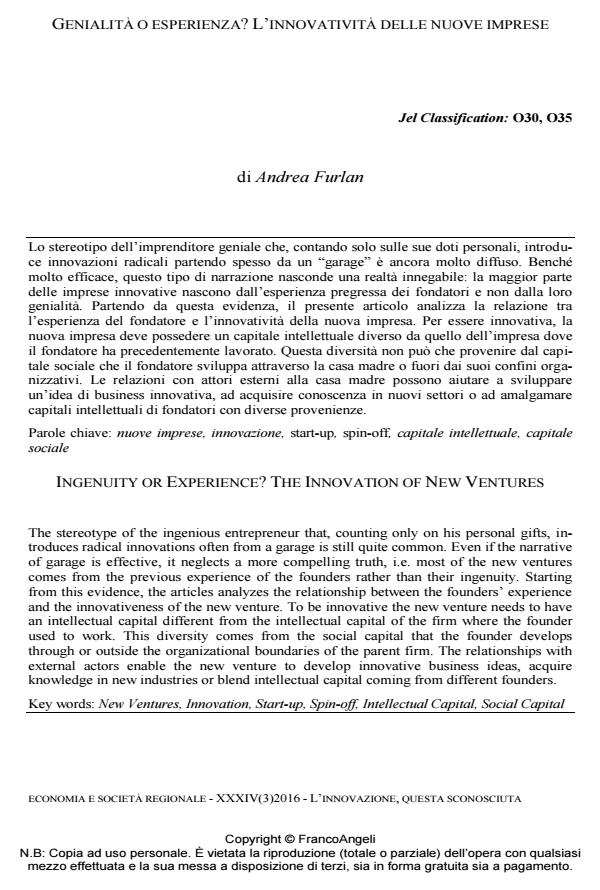Ingenuity or experience? the innovation of new ventures
Journal title ECONOMIA E SOCIETÀ REGIONALE
Author/s Andrea Furlan
Publishing Year 2017 Issue 2016/3 Language Italian
Pages 16 P. 68-83 File size 239 KB
DOI 10.3280/ES2016-003005
DOI is like a bar code for intellectual property: to have more infomation
click here
Below, you can see the article first page
If you want to buy this article in PDF format, you can do it, following the instructions to buy download credits

FrancoAngeli is member of Publishers International Linking Association, Inc (PILA), a not-for-profit association which run the CrossRef service enabling links to and from online scholarly content.
The stereotype of the ingenious entrepreneur that, counting only on his personal gifts, introduces radical innovations often from a garage is still quite common. Even if the narrative of garage is effective, it neglects a more compelling truth, i.e. most of the new ventures comes from the previous experience of the founders rather than their ingenuity. Starting from this evidence, the articles analyzes the relationship between the founders’ experience and the innovativeness of the new venture. To be innovative the new venture needs to have an intellectual capital different from the intellectual capital of the firm where the founder used to work. This diversity comes from the social capital that the founder develops through or outside the organizational boundaries of the parent firm. The relationships with external actors enable the new venture to develop innovative business ideas, acquire knowledge in new industries or blend intellectual capital coming from different founders.
Keywords: New Ventures, Innovation, Start-up, Spin-off, Intellectual Capital, Social Capital
- Agarwal R., Echambadi R., Franco A.M. and Sarkar M. (2004). Knowledge Transfer through Inheritance: Spin-out Generation, Development, and Survival. Academy of Management Journal, 47(4): 501-522, DOI: 10.2307/20159599
- Anastasia B., Furlan A. e Pitingaro R. (2015). Manifattura e nuova imprenditorialità in Veneto. economia e società regionale, 33(1): 102-124, DOI: 10.3280/ES2015-001008
- Audia P.G. and Rider C.I. (2005). A Garage and an Idea: what more does an entrepreneur need?. California Management Review, 48(1): 6-28, DOI: 10.2307/41166325
- Bettiol M. e Furlan A. (2014). Istruiti, esperti, autofinanziati: ritratto degli imprenditori italiani oltre i cliché. Corriere Innovazione, 10 ottobre.
- Birley S. (1985). The Role of Networks in the Entrepreneurial Process. Journal of Business Venturing, 1(1): 107-117.
- Camuffo A. and Grandinetti R. (2011). Italian Industrial Districts as Cognitive Systems: are they still reproducible? Entrepreneurship & Regional Development, 23(9-10): 815-852, DOI: 10.1080/08985626.2011.577815
- Chatterji A.K. (2009). Spawned with a Silver Spoon? Entrepreneurial Performance and Innovation in the Medical Device Industry. Strategic Management Journal, 30(2): 185-206,
- Dahl M.S. and Reichstein T. (2007). Are you Experienced? Prior Experience and the Survival of new Organizations. Industry and Innovation, 14(5): 497-511, DOI: 10.1080/13662710701711414
- Eriksson T. and Kuhn J.M. (2006). Firm Spin-offs in Denmark, 1981-2000: Patterns of Entry and Exit. International Journal of Industrial Organization, 24(5): 1021-1040,
- Furlan A. (2016). Who lives longer? Start-ups vs Spin-offs Founded as Proprietorships. International Journal of Entrepreneurial Behavior & Research, 22(3): 416-435,
- Furlan A. and. Grandinetti R. (2016). Spin-offs and their Endowments: beyond the Knowledge Inheritance Theory. Journal of Intellectual Capital, 17(3): 570- 589, DOI: 10.1108/JIC-02-2016-0023
- Johannisson B. (1988). Business Formation: a Network Approach. Scandinavian Journal of Management, 4(3-4): 83-99.
- Klepper S. (2009). Spin-offs: a Review and Synthesis. European Management Review, 6(3): 159-171,
- Klepper S. (2010). The Origin and Growth of Industry Clusters: the Making of Silicon Valley and Detroit. Journal of Urban Economics, 67(1): 5-32.
- Klepper S. and Sleeper S. (2005). Entry by spin-offs. Management Science, 51(8): 1291-1306,
- Nahapiet J. and Ghoshal S. (1998). Social Capital, Intellectual Capital, and the Organizational Advantage. Academy of Management Review, 23(2): 242-266.
- Shane S. and Venkataraman S. (2000). The Promise of Entrepreneurship as a Field of Research. Academy of Management Review, 25(1): 217-226.
- Stuart T.E. and Ding W.W. (2006). Why do Scientists become Entrepreneurs? The Social Structural Antecedents of Commercial Activity in the Academic Life Sciences. American Journal of Sociology, 112(1): 97-144, DOI: 10.1086/502691
Andrea Furlan, Genialità o esperienza? L’innovatività delle nuove imprese in "ECONOMIA E SOCIETÀ REGIONALE " 3/2016, pp 68-83, DOI: 10.3280/ES2016-003005